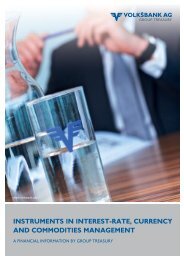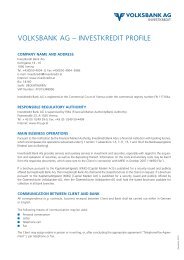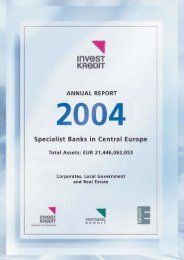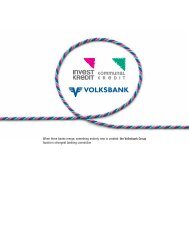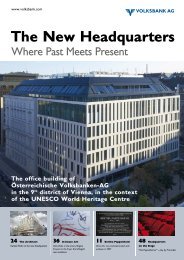Download - Volksbank AG
Download - Volksbank AG
Download - Volksbank AG
Create successful ePaper yourself
Turn your PDF publications into a flip-book with our unique Google optimized e-Paper software.
THE ST<strong>AG</strong>ES OF PROJECT FINANCE<br />
TRANSACTIONS<br />
Project finance transactions usually consist of the following four steps<br />
Financial close<br />
Planning<br />
Construction<br />
Commissioning<br />
Operation<br />
Project team<br />
Feasibility study<br />
Financing package,<br />
Financing model<br />
Offer,<br />
negotiations<br />
Authorisations<br />
(authorities)<br />
Formation of<br />
special purpose company<br />
Completion<br />
Financing<br />
Completion<br />
Supply<br />
Construction<br />
Tests<br />
Handover<br />
Acceptance<br />
Commissioning<br />
Operation<br />
Maintenance<br />
PLANNING<br />
Step 1<br />
The planning phase is very complex due to the parallel<br />
nature of the individual tasks. The result of this phase is a<br />
business plan; its implementation begins in the second phase.<br />
Of crucial importance are the financing plan and the financial<br />
model. In order to ensure the availability of the financing in<br />
good time, it is recommended that banks and investors are<br />
involved as early as possible in the planning process.<br />
COMMISSIONING<br />
Step 3<br />
This phase is a particularly critical part of the project as this<br />
is when the project is accepted by the sponsor and because<br />
the ability to invoice the services is dependent on the full<br />
functionality of the asset. From the bank’s point of view, once<br />
the project has been properly accepted and commissioned<br />
one of the core risks – the completion risk – has been<br />
eliminated.<br />
CONSTRUCTION<br />
Step 2<br />
In the construction phase it is essential to complete the<br />
investment on time, within the planned budget and accord -<br />
ing to the specifications and the functionality laid down<br />
in the construction contract. Initial tests lead to the commissioning.<br />
OPERATION<br />
Step 4<br />
In the operating phase, the asset is managed and continuously<br />
maintained. The generated revenues cover the run -<br />
ning costs and are used to amortise the financing.<br />
6



